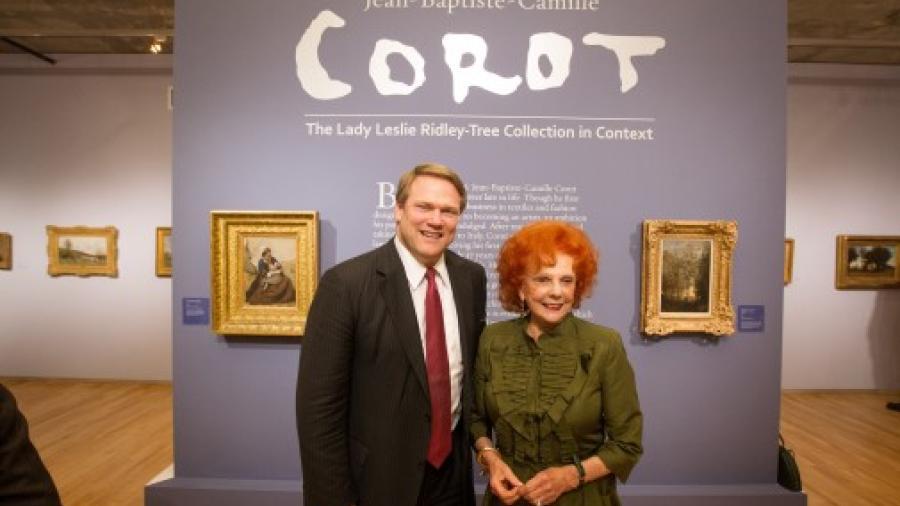Westmont Magazine Corot: The Man Behind the Masterpiece

by Gayle D. Beebe, Ph.D., President
Jean-Baptiste-Camille Corot, the most important landscape painter in France in the late 19th century, inspired a new generation of French landscape artists. Although he never officially lived in Barbizon, a small town in the Forest of Fontaine Bleau, his name is associated with many Barbizon artists. These artists prized naturalism and a true-to-life depiction of the real world; sentimentality and artifice had no value for them. They gravitated toward the unspoiled beauty of the Fontaine Bleau Forest and sought subjects for their paintings among laborers, peasant women and the untamed beauty of the flora and fauna of the French countryside. Corot was struck by the unspoiled beauty he found at the Fontaine Bleau Forest and returned often to paint the pristine landscapes.
Biographies perpetuate the myth of Corot as an uneducated, simple man, which is far from the truth about his character. While he did not distinguish himself as an academic student in his formative years, Corot received a well-rounded education. As an adult, he read Racine and Virgil; he listed his favorite authors as Blaise Pascal and Jacques-Benigne Bossuet, a French historian. He often entertained friends by reciting poetry; Shakespeare was his favorite poet.
Corot had a fine singing voice. He loved music and attended concerts whenever possible—sometimes two or three times a week. He preferred Gluck’s operas and Beethoven’s symphonies. Many critics think Corot’s landscapes suggest a harmonious mood. Certainly, his focus on evoking feelings and emotions toward nature resembles the melodic enjoyment of music.
Corot often dressed like a peasant, but he achieved wealth and success. He was an introvert, someone comfortable with close friends but shy in ceremonial or social situations. Yet Corot enjoyed a large, welcoming circle of close friends who housed him as he traveled.
The artist Charles Daubigny found in Corot a confidant and adviser. “He is a perfect old man; Joy, this Father Corot,” said Daubigny. “He is altogether a wonderful man, who mixes jokes in with his very good advice.”1
Although he never married, Corot loved women, including a young woman who worked in his mother’s millinery shop and later “the prettiest ballerina of the Bolognaopera house.” When his father tried to arrange a marriage, Corot responded that he planned to devote his life to his art.
His closest artist friends called him Père Corot—or Papa Corot—a moniker of love and respect. His generosity was legendary. He founded a hospital for infants in Paris. He bought a house for Honoré Daumier, who in his old age was blind and without resources. Millet, who struggled with poverty all his life, died leaving little for his widow; Corot quietly arranged an annual allowance for her.
Corot’s humble character sprang from a deeply spiritual inner life. Every day he read from Thomas à Kempis’s “The Imitation of Christ,” which served as a meditative tool for Corot. The message of this book focuses on the importance of the interior life as opposed to the ruthless and heady pleasures of the world.
Above all, Corot loved nature, and he loved to paint landscapes. His joy in painting is evident in a letter he wrote to his artist friend, Jules Dupré, describing a typical day of painting:
A landscape painter has a delightful day. He gets up about 3 a.m., before sunrise; he goes out, sits down under a tree, and waits, watching. At first there is little to be seen. . . . Everything is sweetly scented, and trembles under the wakening breeze of the dawn. . . . First one ray of sunshine then another. The flowers awake. The birds begin to twitter their morning prayers. One sees nothing, yet all is there. . . . The sun arises. Everything sparkles and glitters, all is in full light, still soft and caressing; and I paint! I paint! The far distance in its simple contour and harmony fades into the sky, through an atmosphere of mist and ether. . . and the artist? He paints!. . . [Now the sun is fully up]. . . “We see too much. There is nothing left to the imagination. Let us go to breakfast at the farm. . . I will doze and dream of my morning scene. I will dream of my picture; and, later on, I will paint my dream.”2
Lady Leslie Ridley-Tree has generously made a bequest of her Corot collection to the Westmont Ridley-Tree Museum of Art, and I thank her for her generosity in sharing her carefully considered collection with us. Our goal for the exhibit “Jean-Baptiste-Camille Corot: The Lady Leslie Ridley-Tree Collection in Context” is to reveal the ethereal vision of Corot’s dreams. Lady Ridley-Tree’s ability to see beyond the next horizon has opened an unparalleled opportunity for the college and our students.
1Gary Tinterow, Michael Pantazzi, Vincent Pomarède, Corot (New York: Harry N. Abrams and the Metropolitan Museum of Art, 1996), p. 271.
2Quoted from the translation of William Knight, “Six Lectures on Some Nineteenth Century Artists English and French,” delivered at the Art Institute of Chicago in 1907 (Chicago: The Art Institute of Chicago, 1909), pp. 53-54.